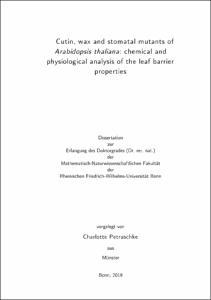Cutin, wax and stomatal mutants of Arabidopsis thaliana: chemical and physiological analysis of the leaf barrier properties

Cutin, wax and stomatal mutants of Arabidopsis thaliana: chemical and physiological analysis of the leaf barrier properties

| dc.contributor.advisor | Schreiber, Lukas | |
| dc.contributor.author | Petruschke, Charlotte | |
| dc.date.accessioned | 2020-04-26T23:05:32Z | |
| dc.date.available | 2020-04-26T23:05:32Z | |
| dc.date.issued | 08.10.2019 | |
| dc.identifier.uri | https://hdl.handle.net/20.500.11811/8075 | |
| dc.description.abstract | Stomatal pores and the cuticular membrane are the two major key elements to regulate the gas exchange and water balance of plants. The hydrophobic cuticle covers all aerial parts of plants in their primary developmental stage (Schönherr, 1982). It forms an effective barrier against uncontrolled water loss and thus prevents plants from desiccation (Edwards et al., 1982). Stomata perforate the cuticular membrane and are indispensable for the uptake of CO2 and the release of O2 to maintain photosynthesis. This gas exchange is accompanied by the controlled release of water vapor. If the plant is exposed to drought, stomata close. Under these conditions, the plant's survival depends on the amount of water lost through the cuticle. To further understand this important interplay between stomatal regulation and the permeability of the cuticular membrane a multifaceted approach investigating stomatal and cuticular mutants for (i) their stomatal distribution, (ii) cuticular wax and cutin amounts as well as compositions and (iii) the physiological role in terms of transpiration either through the cuticular membrane or the stomata has been accomplished. Chemical analyses for wax/ cutin amounts and compositions revealed no significant correlation with determined stomatal densities or indexes. Even though in a few mutants, such as st-RNAi and wax2 which showed lower stomatal densities and at the same time lower wax amounts, no clear pattern of such regularities could be observed for all the mutants. Inconsistencies, for instance, were underlined by observations for the wax mutant shn3, which exhibited higher wax amounts but a lower stomatal density than the wild type. Further measurements of the cuticular permeability and stomatal conductance could not be correlated to the determined wax/ cutin amounts or the stomatal densities and indexes. Cuticular transpiration was increased in all mutants independently from increased or decreased stomatal densities or cutin/ wax amounts. In summary, this data indicates that the simple assumption that stomatal density correlates with wax or cutin amounts may not always be true. Further physiological data underline those findings because the permeability of the cuticle does not seem to be integrated with the density or pattern of the stomata and likewise, the conductance of stomata is not linked to the deposition of wax or cutin amounts. | en |
| dc.language.iso | eng | |
| dc.rights | In Copyright | |
| dc.rights.uri | http://rightsstatements.org/vocab/InC/1.0/ | |
| dc.subject.ddc | 570 Biowissenschaften, Biologie | |
| dc.title | Cutin, wax and stomatal mutants of Arabidopsis thaliana: chemical and physiological analysis of the leaf barrier properties | |
| dc.type | Dissertation oder Habilitation | |
| dc.publisher.name | Universitäts- und Landesbibliothek Bonn | |
| dc.publisher.location | Bonn | |
| dc.rights.accessRights | openAccess | |
| dc.identifier.urn | https://nbn-resolving.org/urn:nbn:de:hbz:5n-55812 | |
| ulbbn.pubtype | Erstveröffentlichung | |
| ulbbnediss.affiliation.name | Rheinische Friedrich-Wilhelms-Universität Bonn | |
| ulbbnediss.affiliation.location | Bonn | |
| ulbbnediss.thesis.level | Dissertation | |
| ulbbnediss.dissID | 5581 | |
| ulbbnediss.date.accepted | 20.09.2019 | |
| ulbbnediss.institute | Mathematisch-Naturwissenschaftliche Fakultät : Fachgruppe Biologie / Institut für Zelluläre und Molekulare Botanik (IZMB) | |
| ulbbnediss.fakultaet | Mathematisch-Naturwissenschaftliche Fakultät | |
| dc.contributor.coReferee | Koch, Kerstin |
Files in this item
This item appears in the following Collection(s)
-
E-Dissertationen (4398)




